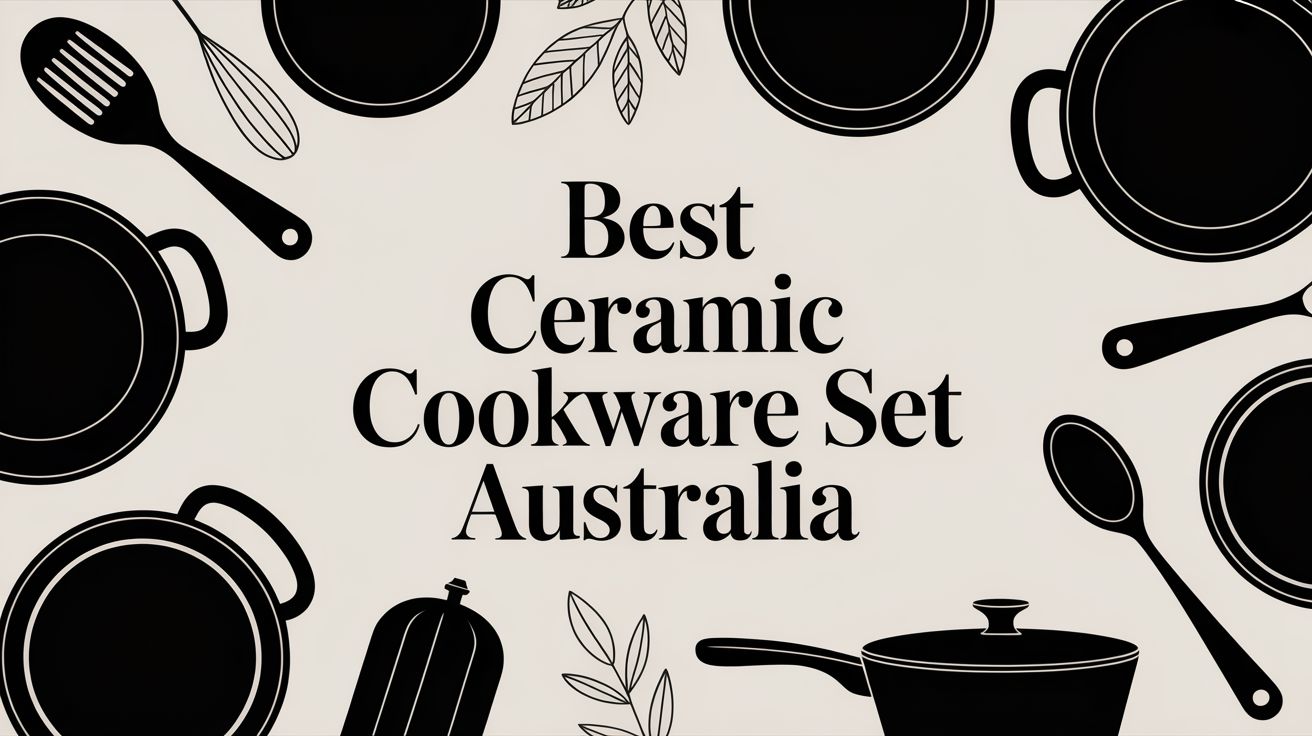Shopping for a ceramic cookware set in Australia? You’re most likely looking at metal cookware—usually aluminium—that's been finished with a slick, non-stick ceramic coating. This modern take on cookware is fast becoming a staple in Aussie homes, and for good reason. It’s all driven by our growing desire for healthier, non-toxic kitchen tools that also look great in a contemporary kitchen.
Why Ceramic Cookware Is a Top Choice for Australian Kitchens
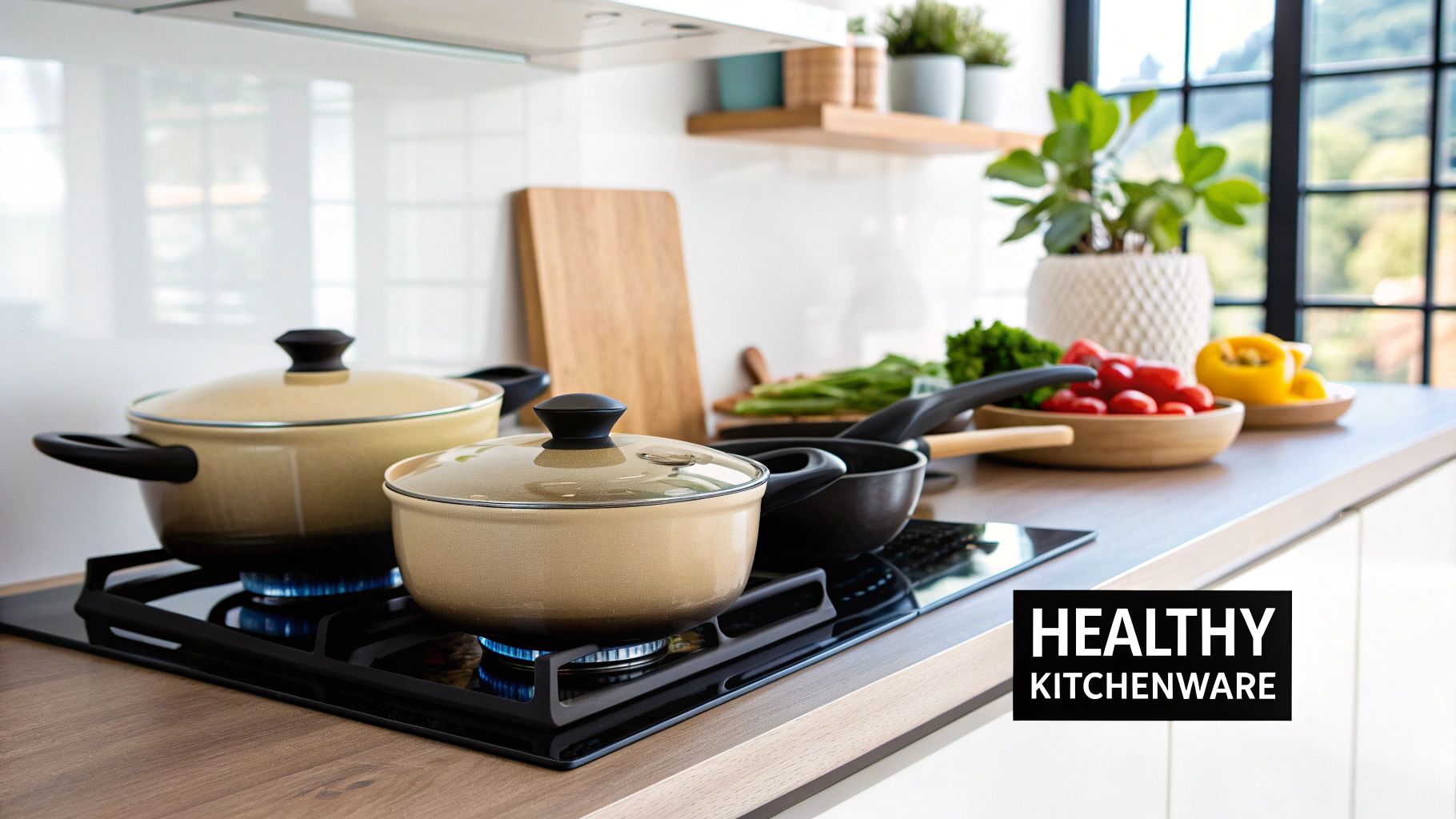
First things first, let's clear up a common point of confusion. When you hear the term ceramic cookware set, we're not usually talking about pots and pans made from 100% pure ceramic clay, like your grandma's old casserole dish. Today, the term almost always means cookware with a metal core and a ceramic non-stick finish.
It's a simple but brilliant design. The pan has a strong, heat-conductive metal body (often aluminium because it's lightweight and heats up quickly) doing all the hard work. Fused to the inside is an incredibly thin, glass-like layer of ceramic coating made from a sand-like mineral. This special sol-gel coating is what gives you that silky smooth, non-stick cooking surface.
The Shift Towards Healthier Cooking
A huge part of ceramic cookware’s rise in Australia comes down to health. For decades, the go-to non-stick pans were made with coatings containing chemicals like PTFE (you might know it by the brand name Teflon) and PFOA.
As we’ve learned more, concerns have grown around these "forever chemicals," which can start to break down and release fumes at very high temperatures. Naturally, as Aussies become more conscious of what goes into their food, the hunt for safer alternatives has ramped up.
This is where ceramic cookware really shines. It offers a cooking surface that is completely free from PTFE, PFOA, lead, and cadmium. That gives home cooks genuine peace of mind, knowing their pans won’t leach unwanted chemicals into family meals—even if they accidentally get a bit too hot.
This focus on non-toxic materials lines up perfectly with the bigger wellness trends we're seeing everywhere, from clean eating to a preference for organic produce.
Aesthetics Meet Functionality in the Modern Kitchen
Health benefits aside, let's be honest—the stunning look of a ceramic cookware set is a massive drawcard. Modern Australian kitchen design is all about clean lines, natural light, and stylish pops of colour. Ceramic cookware slides into this aesthetic beautifully.
Forget the standard black or grey of old-school non-stick. Ceramic sets come in a whole spectrum of colours, from soft, earthy pastels to bold, eye-catching hues. It means you can finally choose cookware that not only performs brilliantly but also doubles as a design feature.
Many brands are now designing sets that are so attractive they can go straight from the stove to the centre of your dining table. This blend of form and function really clicks with our love for practical, beautiful things that make our homes feel better. When you choose a ceramic cookware set in Australia, you’re just as much upgrading your kitchen's style as you are your cooking.
The Real Benefits of Cooking with Ceramic
Picking out a new cookware set is a big decision for any kitchen, and the perks of going ceramic are more than just skin deep. For Aussie home cooks, the advantages really hit home, lining up perfectly with our growing focus on healthy living, efficiency, and sustainability. The real magic is in how these pans handle the daily grind, making cooking a pleasure and cleanup a breeze.
The biggest drawcard for most people is the peace of mind that comes from cooking with non-toxic materials. Traditional non-stick pans have a history of using chemicals like PFOA and PTFE, but ceramic coatings are made from natural minerals. This means they’re completely free of these controversial compounds, along with heavy metals like lead and cadmium.
That’s a massive win for your health. When older PTFE-based pans get too hot, they can release fumes you'd rather not have in your kitchen. With a ceramic surface, that worry is completely off the table. You can be confident the food you’re serving is just as clean and safe as the ingredients you started with.
This infographic breaks down the key benefits you can expect from a top-notch ceramic cookware set in Australia.
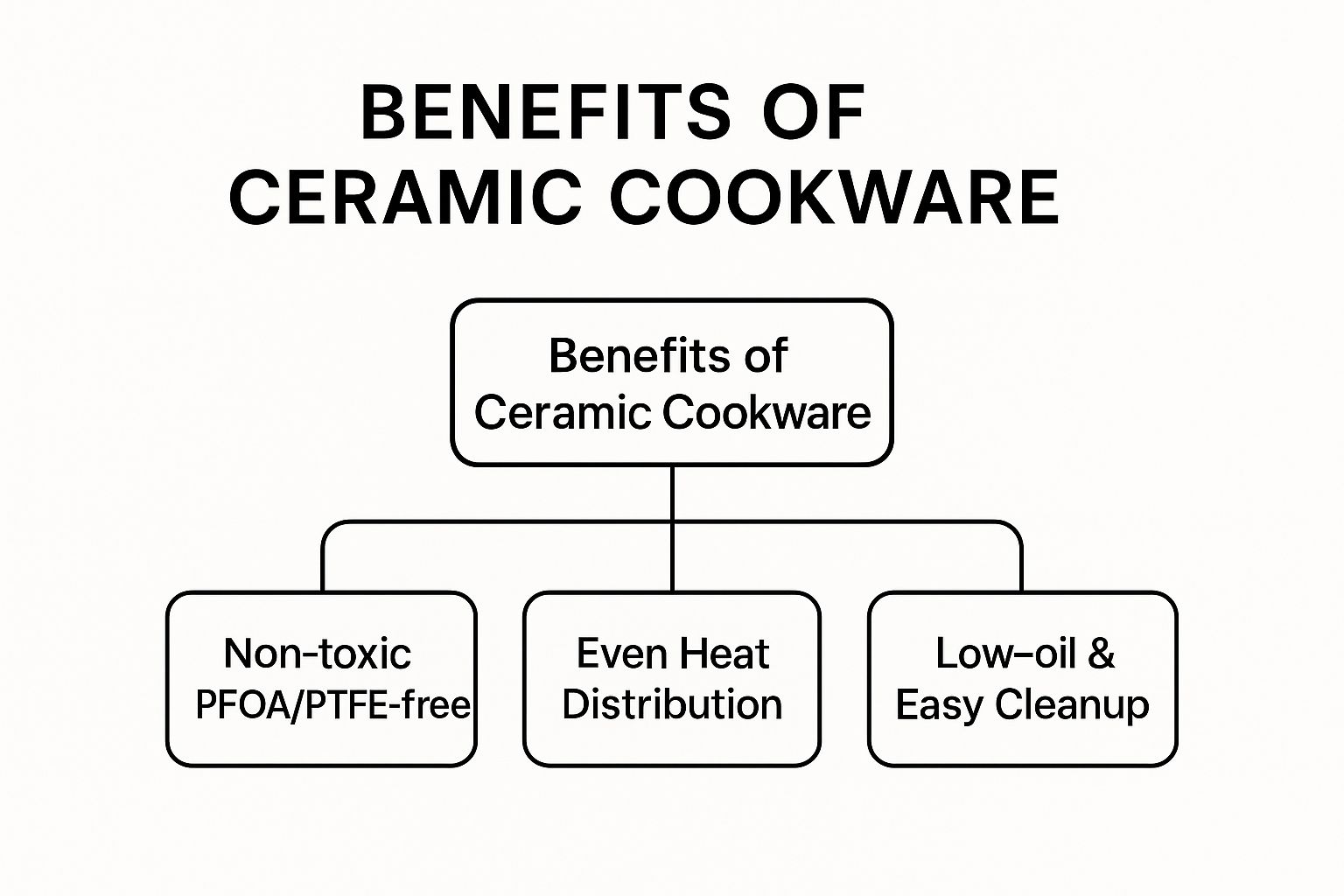
As you can see, it all comes down to a fantastic blend of health, performance, and pure convenience. Each of these pillars works together to deliver a better, safer cooking experience every day.
Superior Performance and Easy Cleanup
Beyond being non-toxic, the way ceramic pans perform is what truly wins people over. The surface is incredibly smooth and non-porous, which gives it its amazing non-stick power. For you, this means you can cook with far less oil or butter—a real bonus if you’re trying to whip up healthier meals.
Foods like eggs, pancakes, and delicate fish fillets just glide right off the pan. This doesn't just make cooking less of a headache; it makes cleaning up ridiculously simple. Forget about intense scrubbing. A quick wipe with a soft sponge and some warm, soapy water is usually all it takes to get your pan looking brand new.
The secret to that effortless food release is the sol-gel manufacturing process. It creates a dense, glass-like layer that food simply can't grab onto, which is why ceramic pans are so famous for their easy-peasy cleanup.
Efficient and Even Heat Distribution
Ever had a pan that burns your food on one side while the other is barely cooked? That’s the work of “hot spots,” a classic sign of poor heat distribution. Quality ceramic cookware tackles this problem head-on. Most have an aluminium core, which is a fantastic conductor of heat.
This means when you pop the pan on the stove, the heat spreads quickly and evenly across the entire base, from the dead centre right out to the edges. This consistent heating ensures your food cooks perfectly every time. You get more control, a beautiful sear on your steak, and evenly browned veggies without having to constantly move things around the pan.
If you’re keen to dive deeper into what separates a good pan from a great one, you can learn more about the best healthy cooking pans in our detailed guide.
An Environmentally Conscious Choice
Finally, choosing ceramic cookware is often a more sustainable decision. The sol-gel process used to create the ceramic coating is generally considered more environmentally friendly than how traditional PTFE coatings are produced.
It typically releases fewer chemicals and uses less energy, resulting in a smaller carbon footprint overall. For the eco-conscious Aussie, grabbing a ceramic cookware set is a practical way to get high-performance tools for your kitchen while making a choice that’s a little kinder to the planet. It’s a win for your health and a win for the environment.
How to Choose Your Ideal Ceramic Cookware Set
Walking into a cookware aisle can feel a bit overwhelming, but picking the right ceramic cookware set in Australia really just boils down to knowing what to look for. Once you get a handle on a few key features, you can easily find a set that fits your cooking style, your kitchen, and your budget.
Think of it this way: a ceramic pan is a lot like a high-performance car. The shiny, slick surface is what catches your eye, but what’s under the bonnet is what truly determines its performance and how long it’ll last.
What's at the Core?
The metal body of a ceramic pan is its engine. This core material dictates how well it heats up, how it feels in your hand, and its overall toughness. You'll generally come across two main options:
- Aluminium: This is the crowd favourite, and for good reason. Aluminium is incredibly lightweight and a fantastic heat conductor, which means your pans get hot quickly and evenly. No more frustrating hot spots that scorch one side of your dinner while the other is still cooking.
- Stainless Steel: Often found in multi-ply or "clad" cookware, stainless steel brings some serious muscle to the table. It adds durability, weight, and resistance to rust. If you've got an induction cooktop, a set with a stainless steel base is usually non-negotiable.
While a solid aluminium core is brilliant for most day-to-day cooking, a multi-ply construction that layers both metals can give you the best of both worlds—fast, even heating combined with rock-solid durability.
The Quality of the Coating
That smooth ceramic coating is where the non-stick magic really happens. But here’s the thing: not all coatings are made equal. The quality and thickness of this layer directly affect how long your pan will keep its slick, easy-release surface.
Look for brands that are upfront about their coating technology. Some of the better sets will boast multiple layers of ceramic, often reinforced with tough materials like diamond or titanium to boost scratch resistance. A thicker, more robust coating is simply going to stand up better to daily use.
A single, flimsy layer of coating might look great new, but it can lose its non-stick power surprisingly fast. Investing in a set with a multi-layered, reinforced coating is one of the smartest things you can do to make sure your cookware lasts for years, not just a few months.
Handles and Oven-Friendliness
It's an easy detail to overlook, but the handles are so important for a safe and comfortable cooking experience. You want handles that are ergonomically designed and feel good to hold. More importantly, check that they are stay-cool handles, which are usually made from stainless steel or wrapped in silicone to stop them from getting dangerously hot on the stovetop.
Also, think about how you cook. Do you love searing a steak on the stove and then finishing it in the oven? If that's you, then oven-safe temperature limits are a must-have.
- Always check the maximum oven temperature the cookware can withstand.
- Make sure the lids are also oven-safe—sometimes they have a lower heat limit than the pan itself.
This kind of versatility opens up a whole new world of recipes, from a perfectly cooked frittata to a beautifully braised casserole.
Is It Induction-Ready?
For many Aussie homes, this is a deal-breaker. Induction cooktops are becoming more and more popular for their speed and safety, but they only work with cookware that has a magnetic base. The ceramic coating has nothing to do with it; it's all about what the pan is made of underneath.
To work on an induction stove, the cookware needs a ferromagnetic base—typically made from iron or magnetic-grade stainless steel. Before you buy, always look for the induction symbol (it looks like a little coil of wire) on the box or in the product description. Don't just guess, always double-check.
Here’s a handy checklist to keep in mind when you're comparing different sets.
Ceramic Cookware Feature Comparison Checklist
Use this quick guide to compare different ceramic cookware options and ensure you're getting a set that ticks all the right boxes for your kitchen.
| Feature | What to Look For | Why It Matters |
|---|---|---|
| Core Material | Aluminium, Stainless Steel, or a multi-ply combination. | Determines heat distribution, weight, and durability. Aluminium is light and heats fast; stainless steel adds strength. |
| Coating Quality | Multi-layered, reinforced with materials like diamond or titanium. | A thicker, higher-quality coating will last longer and provide better non-stick performance over time. |
| Handle Design | Ergonomic, stay-cool handles (stainless steel or silicone-wrapped). | Ensures a safe, comfortable grip that won't get too hot to handle on the stovetop. |
| Oven Safety | A clearly stated maximum oven-safe temperature for both pans and lids. | Gives you the versatility to move dishes from the stovetop to the oven for finishing or baking. |
| Induction Compatibility | A ferromagnetic (magnetic) base. Look for the induction symbol. | Absolutely essential if you have an induction cooktop, as non-compatible cookware simply won't heat up. |
| Lids | Tempered glass lids with steam vents are ideal. | Lets you monitor your cooking without losing heat, and the vent prevents pressure build-up. |
By running through this checklist, you can move past the marketing hype and focus on the features that will genuinely make a difference in your daily cooking.
The Australian kitchenware market is buzzing, which just goes to show how much we all love cooking at home with quality gear. This demand is driving the availability of great, feature-packed options like a versatile ceramic cookware set in Australia. You can read more about Australian kitchenware market trends on Statista. And if you're specifically after pans with lids, our guide on finding the best non-stick frying pans with lids has you covered.
Comparing the Top Ceramic Cookware Brands in Australia
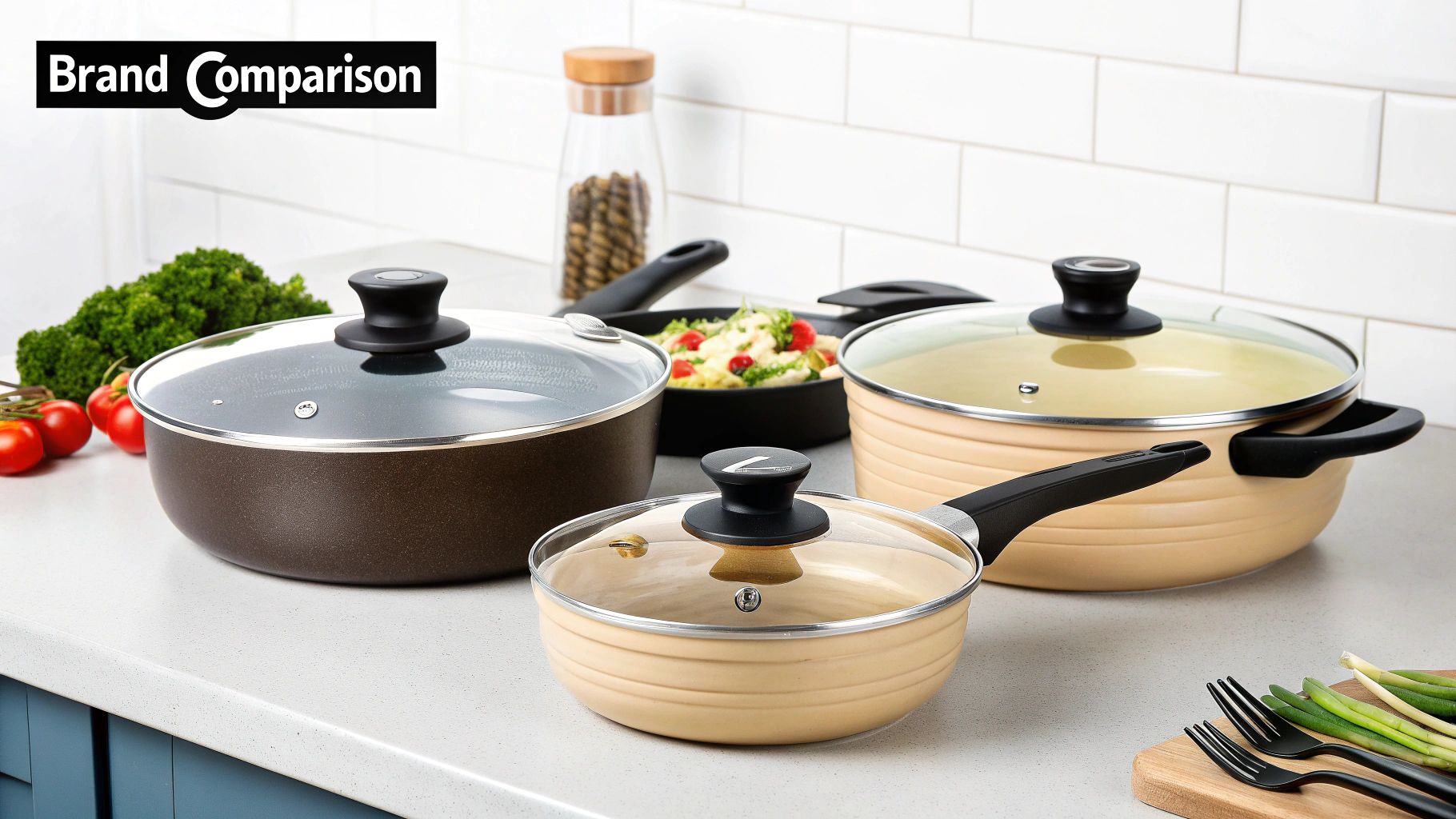
Alright, you know what makes a good ceramic pan tick. Now, let's put that knowledge to work and see what’s actually on the shelves here in Australia. You’ll find a mix of global heavy-hitters and local darlings, each bringing something different to the table. We’ll go beyond a simple list and actually stack them up against the features we’ve just covered to help you find the right fit for your kitchen.
It’s no secret that more of us are getting into home cooking, and that’s really shaken up the cookware market. Brands are pushing the boundaries to deliver safer, longer-lasting, and better-performing gear. This is fantastic news when you're shopping for a ceramic cookware set in Australia, as the options are better than ever. You can get a deeper look at what’s driving this trend with these insights into the Australian cookware market.
Let's put a few of the most popular brands under the microscope.
GreenPan: The Innovator
If you've heard of ceramic non-stick, you can probably thank GreenPan. They really kicked off the whole category back in 2007. Their entire brand is built on their signature Thermolon coating, which is derived from sand and is completely free of PFAS, PFOA, lead, and cadmium. They’ve set the benchmark for what clean, non-stick cooking can be.
- Core Construction: They mostly use hard-anodised or recycled aluminium, which is a fantastic choice for fast, even heating and overall toughness.
- Coating Resilience: Their top-tier collections are seriously impressive, featuring diamond-infused coatings (like their Infinite8 tech). This makes them incredibly scratch-resistant—some are even tough enough to handle metal utensils.
- Set Composition: You can find everything from a simple starter duo to a full 11-piece collection, often with handy extras like silicone utensils thrown in.
GreenPan's dedication to improving its coatings and its focus on sustainability make it a top pick for anyone wanting a long-lasting, eco-friendly set. You’ll pay a bit of a premium, but the investment gets you cutting-edge tech and solid warranties.
Caraway: The Design Darling
Caraway burst onto the scene with cookware that’s as beautiful as it is functional. With their stunning colour palettes and genius storage solutions, they’re a magnet for the modern home cook who wants a kitchen that looks as good as it performs. They’ve really nailed the idea of a complete, organised cooking system.
The brand's non-toxic credentials are front and centre in their marketing, making them a go-to for the health-conscious crowd. And while they look incredible on the stove, it's worth knowing how to care for that beauty.
Caraway's ceramic coating is gorgeous, but it needs a bit of TLC. To keep it perfectly non-stick, you really need to stick to low-to-medium heat, avoid metal utensils, and always hand wash. This is good practice for any ceramic pan, but it's especially crucial when the aesthetics are a major part of the appeal.
Scanpan: A Legacy of Quality
While it's a Danish brand, Scanpan has a massive and well-earned reputation in Australia for top-quality, built-to-last cookware. They're famous for their Stratanium+ non-stick (which is PTFE-based), but they also make fantastic ceramic-titanium pans for those after a PFOA-free option.
- Core Construction: Their pans are made from 100% recycled, squeeze-cast aluminium. This process eliminates air bubbles, giving you flawless heat distribution and a base that absolutely will not warp. Ever.
- Coating Resilience: The ceramic-titanium surface is legendary for its toughness. It’s built to withstand serious use and resist abrasion for years.
- Price and Warranty: Scanpan sits at the higher end of the market, but the price is backed by phenomenal build quality and, often, a limited lifetime warranty. That's a company that stands by its product.
Choosing Scanpan is a long-term investment. It's the kind of cookware engineered to be passed down, making it a favourite for serious home cooks and even professional chefs.
Choosing the Right Brand for Your Kitchen
So, which brand is for you? It all comes down to what you value most.
If you’re all about the latest non-toxic technology and a durable finish, GreenPan is probably your best bet. If a stylish, Instagram-worthy kitchen with clever storage is what you dream of, Caraway will deliver. But if you’re looking for professional-grade performance and a pan that will last a lifetime, Scanpan is an investment that pays off.
By weighing these brands against your own checklist—core material, coating quality, oven safety—you can confidently pick a ceramic cookware set in Australia that you'll be excited to use every single day. The best set is always the one that fits the way you cook.
How to Make Your Ceramic Cookware Last Longer
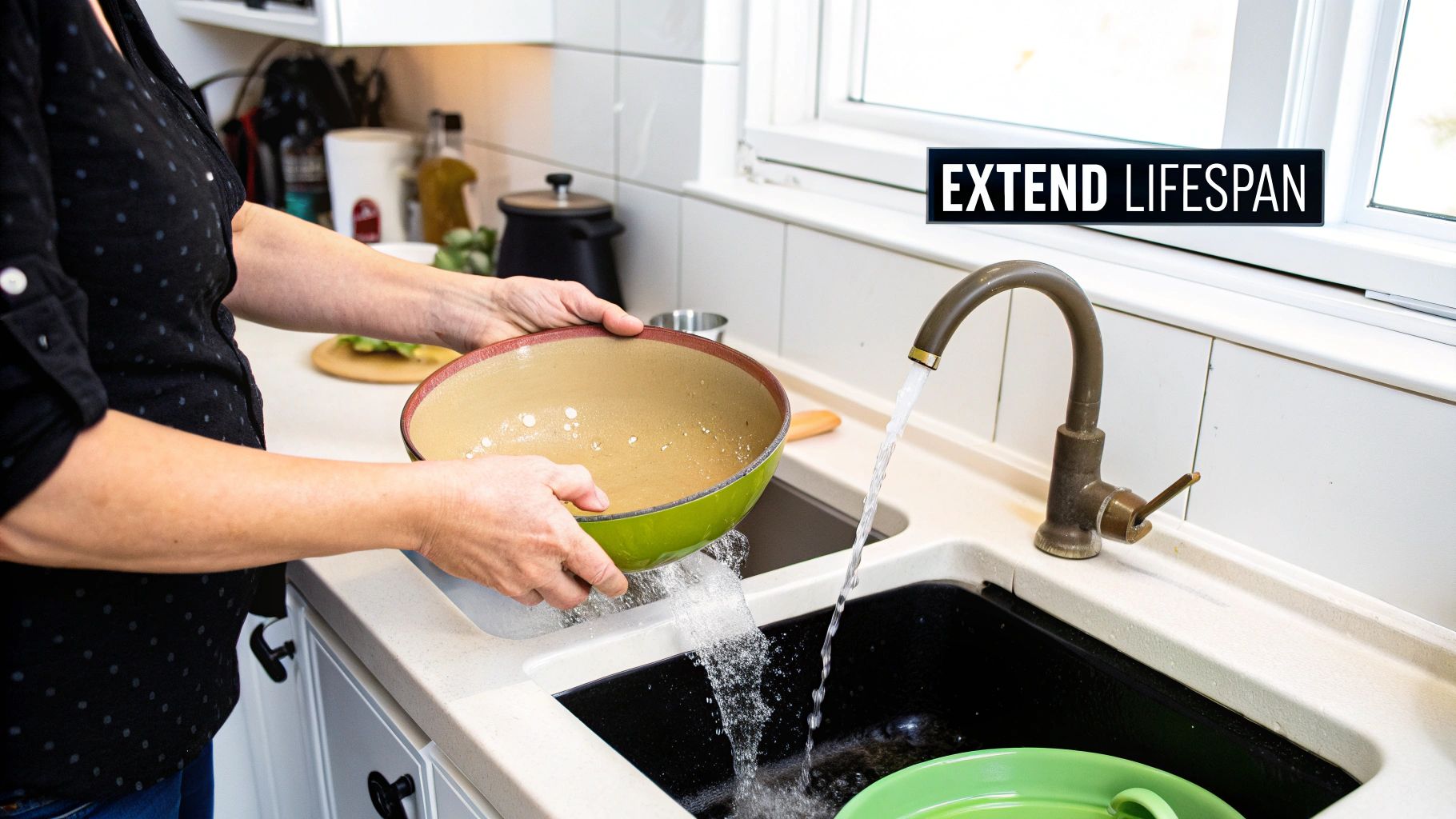
So, you’ve brought home a beautiful new ceramic cookware set in Australia, and you want to keep that slick, non-stick surface performing like new for as long as possible. The good news is, it's not about complex rituals. It all comes down to a few simple habits that protect the delicate ceramic coating.
Think of that ceramic finish like a layer of smooth, hardened glass. It's tough, but it’s not invincible. The biggest culprits that damage it are intense heat, abrasive utensils, and harsh cleaning. Get a handle on these three things, and you'll easily add years to your cookware’s life.
Ceramic cookware is becoming a kitchen staple around the world, and we're seeing that trend right here in Australia. The global market was valued at around USD 5.855 billion in 2024 and is only expected to keep growing as more people look for non-toxic, eco-friendly options. This isn't just a fad; it's a solid shift in what home cooks want. You can dive deeper into the numbers by exploring the global ceramic cookware market trends on Grandview Research.
Master Your Heat and Utensils
If there's one golden rule for preserving your ceramic coating, it's this: avoid high heat. Ceramic pans, especially those with an aluminium core, are brilliant heat conductors. This means you can get a fantastic sear and perfectly even cooking on just a low to medium flame.
Blasting the heat to high is a fast track to thermal shock. This puts immense stress on the coating, potentially causing tiny cracks over time that will ruin its non-stick magic for good. A simple fix? Let your pan preheat for a minute on a medium setting before you add any oil. You'll get the results you want without the risk.
What you cook with matters just as much.
- Go-To Tools: Always reach for utensils made from wood, silicone, bamboo, or nylon. They’re soft and won’t scratch or chip the surface.
- Tools to Avoid: Metal utensils are the natural enemy of ceramic coatings. Metal spatulas, whisks, and forks can easily leave behind permanent scratches, and that's the beginning of the end for your non-stick finish.
Remember this simple rule: if it could scratch your sunglasses, it will scratch your pan. Sticking to soft utensils is one of the easiest ways to ensure your ceramic cookware set lasts.
Smart Cleaning for Lasting Performance
How you clean your pans is just as important as how you cook with them. While some brands might say their pans are dishwasher safe, hand washing is always the better choice if you want them to last. The intense heat, harsh detergents, and general bumping around inside a dishwasher can slowly wear down the non-stick coating.
For everyday cleaning, the first step is to let the pan cool down completely. Dunking a hot pan into cold water is a recipe for warping and can damage the coating. Once it’s cool, a bit of warm, soapy water and a soft sponge or cloth is all you need. Food should slide right off.
If you do end up with some stubborn, burnt-on food, resist the urge to grab the steel wool. Instead, mix up a paste of baking soda and a little water. Spread it over the burnt spot, let it sit for 15 minutes or so, and then gently scrub with a non-abrasive sponge. It works wonders at lifting grime without harming the ceramic. For more insight on what can handle a machine wash, have a look at our guide on dishwasher-safe pans and their care.
Common Questions About Ceramic Cookware
https://www.youtube.com/embed/TeXObJa4D4k
Even after digging into all the details, you might still have a few questions rattling around. That’s completely normal, especially when you’re about to invest in new gear for your kitchen. This last section is all about tackling the most common queries we hear from Aussies, giving you straight, clear answers so you can make your final call with confidence.
Think of this as your final checklist. We've picked out the questions that really get to the heart of what matters—safety, durability, and how these pans will actually hold up in your day-to-day cooking. Let's clear up any last-minute doubts.
Is Ceramic Cookware Really Safer Than Traditional Non-Stick Pans?
Yes, absolutely—especially when it comes to the risk of cooking at high heat. The biggest safety win for ceramic cookware is that its coating is completely free from PTFE (the stuff that makes Teflon) and PFOA. These are the chemicals you'll find in many traditional non-stick pans.
The main worry with PTFE-based coatings is that they can start to break down and release fumes if you accidentally overheat them. With a ceramic surface, that risk just doesn't exist. For everyday cooking at normal temperatures, it gives you a stable, non-reactive, and non-toxic surface to work with.
This offers fantastic peace of mind for health-conscious Australian households. You can cook for your family knowing that the surface is inert and won't leach unwanted chemicals into your food, no matter how hot the pan gets.
This core safety feature is genuinely one of the biggest reasons people are making the switch to ceramic in kitchens all over the country.
How Long Will the Non-Stick Coating Actually Last?
This is a great question, and the honest answer is: it depends. Realistically, you can expect a quality ceramic non-stick surface to perform beautifully for several years with proper care. That’s often a bit shorter than what you might get from a top-tier traditional non-stick pan, but its lifespan is directly in your hands.
Your daily habits make all the difference. The three golden rules for keeping that coating slick are:
- Avoid High Heat: Seriously, stick to low and medium temperatures. High heat is the enemy of ceramic coatings.
- Use Soft Utensils: Reach for wooden, silicone, or nylon tools over metal every time to avoid scratching the surface.
- Hand Wash Gently: The harsh detergents and intense heat in a dishwasher will wear down the coating much faster. A gentle hand wash is best.
It's normal for any non-stick pan to gradually lose some of its slipperiness over time. But follow these simple tips, and you'll get the best possible performance for the longest time.
Will Ceramic Pans Work on My Induction Cooktop?
This is a super common point of confusion. The answer has nothing to do with the ceramic coating itself and everything to do with the pan's base. The coating has zero magnetic properties. For a pan to work on an induction cooktop, it needs a base made from a ferromagnetic material like iron, or it needs a magnetic stainless steel plate bonded to the bottom.
Many modern ceramic cookware sets sold in Australia are specifically designed to be induction-ready, but you can't just assume they all are.
Before you buy, always hunt for the induction symbol on the box or in the online product details. It usually looks like a little coil of wire and is your guarantee that the pan will fire up on your cooktop.
Why Did My New Ceramic Pan Start Sticking Already?
I hear you—it’s incredibly frustrating when a brand-new pan starts to fail you. But when a ceramic pan starts sticking, it’s almost always down to one of two things: invisible residue build-up or heat damage.
Even after a good wash, microscopic food particles can cling to the surface. The next time you heat the pan, these tiny bits and pieces can polymerise, which is just a fancy way of saying they turn into a thin, burnt-on layer that kills the non-stick effect. The fix is usually simple: make a paste of baking soda and water, gently scrub the surface, and rinse it clean.
The other big culprit is just using too much heat. Blasting the pan on high can permanently wreck the coating's delicate structure. One more thing to avoid is aerosol cooking sprays—their propellants can build up on the surface and cause food to stick. Sticking to low-to-medium heat and using a little bit of oil or butter is always the safest bet.
At Everti, we believe in equipping your kitchen with materials that offer both peak performance and complete peace of mind. While our expertise lies in pure, uncoated titanium, we share the same passion for non-toxic, durable, and beautifully designed kitchenware. Discover our collection of lifetime essentials crafted to elevate your daily cooking rituals. Explore the Everti range at https://everti.com.au.

